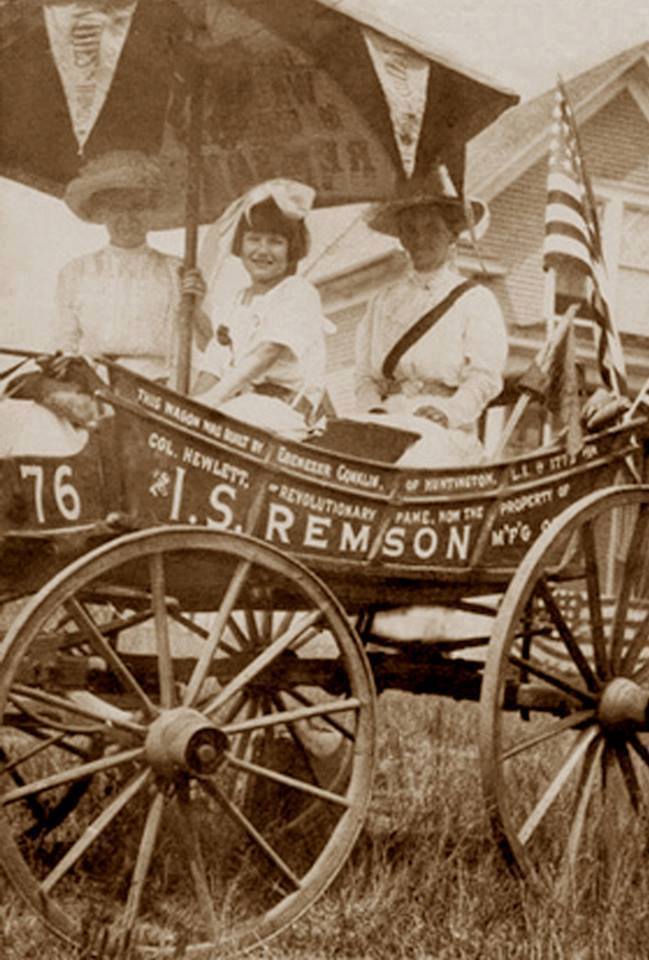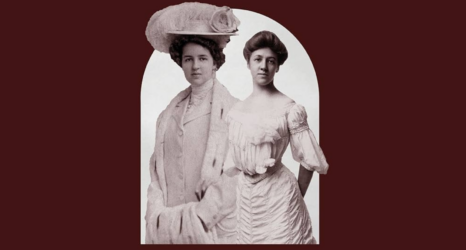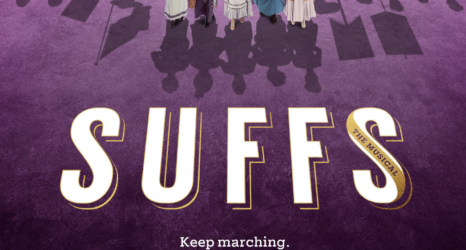
Today in Feminist History is our daily recap of the major milestones and minor advancements that shaped women’s history in the U.S.—from suffrage to Shirley Chisholm and beyond. These posts were written by, and are presented in homage to, our late staff historian and archivist, David Dismore.
July 1, 1913: The campaign to win a women’s suffrage referendum in New York State two years, four months and one day from now has been kicked off in truly revolutionary style!

A wagon, built in 1776 by Ebenezer Conklin—and appropriately named the “Spirit of 1776″—left the Manhattan headquarters of the New York State Woman Suffrage Association this afternoon amid great applause, loaded with suffrage literature and bound for an initial month-long tour of Long Island. It is driven by Edna Kearns and Irene Davidson, with eight-year-old Serena Kearns, Edna’s daughter, along as well. Today, Serena is dressed as “Little Liberty” to symbolize the “little liberty” women have 137 years after “taxation without representation” was denounced as tyranny during the American Revolution.
Drawn by a horse appropriately named “Suffrage,” the wagon and its passengers got an enthusiastic welcome in Jamaica, the first stop on their tour. But they won’t be staying there—or anywhere else—for long. Tomorrow they expect to stop and speak in Springfield, Rosedale, Valley Stream, Lynbrook, Rockville Centre and Oceanside.
The travelers will spend the Fourth of July at a suffrage festival in Long Beach, and then meet up with “General” Rosalie Jones in Ronkonkoma the next day. Jones is a local suffragist who distributed literature from her own horse-drawn cart last spring on Long Island, then did the same in Ohio over the summer to help with the referendum campaign there. She became nationally known as a result of leading suffrage hikes from New York City to Albany from December 16-28, 1912, and from Newark, New Jersey, to Washington, D.C., between February 12 and 28 of this year.
Though full and equal suffrage for women has never been won in any State East of the Mississippi River, the launching of a campaign here is a well-justified manifestation of the growing – and some say unstoppable—momentum our “Votes for Women” movement has been enjoying recently.
Just three years ago the movement had gone fourteen years without a victory of any kind, and women could vote in only four States. But on November 8, 1910, the male voters of Washington State approved a suffrage referendum by an almost two to one margin. The next year brought the biggest victory so far, when on October 10, 1911, California’s male voters approved a suffrage amendment that nearly doubled the number of women voters in the U.S. overnight. Kansas, Oregon, and the newly-admitted State of Arizona followed suit on November 5, 1912. Starting today, women in Illinois have partial suffrage, and are eligible to vote for President as well as local offices, though not for State offices, following passage of a suffrage bill earlier this year by the State Legislature.
But the surge in support for suffrage has become visible in far more spectacular ways than election returns, and it’s events such as the “Spirit of 1776” tour that keep pro-suffrage efforts in the public eye. Until just a little over five years ago, no one had ever marched for suffrage. But two dozen women defied custom – and New York City’s police—to do exactly that on February 16, 1908.
In 1910 a second march had 400 participants. The next year 4,000 turned out. Last year’s parade brought out between 15,000 and 20,000, and this year’s drew about 30,000 marchers and 250,000 spectators to Fifth Avenue. A parade and pageant in Washington, D.C., on March 3rd made nationwide headlines and generated great sympathy for the cause when participants bravely forged ahead despite riotous conditions. The behavior of the unruly crowd and the lack of police protection were so disgraceful that both were strongly denounced even by anti-suffrage newspapers such as the New York Times.
Though there have certainly been many exciting moments in the long history of the suffrage struggle, there has never been more reason for optimism than today. The stagnation of 1896 through 1910 has been forgotten, and no year ends without toasting a victory in at least one State. Massive public spectacles are now routinely pulled off with great success and favorable press coverage. The new Progressive—”Bull Moose”—Party put a woman suffrage plank in its first platform last year.
The Susan B. Anthony Amendment—sometimes called the Bristow-Mondell Amendment after its sponsors in the present Congress—would ban discrimination on account of sex at all polling places in the U.S., and is steadily gaining support in Congress thanks to the efforts of young militants such as Alice Paul, who knows that has to be the ultimate goal.
On June 13 the Senate Woman Suffrage Committee issued a favorable report, making this the first time since 1896 that any Congressional committee has acted on suffrage. The committee members gave their endorsement less than 10 weeks after suffragists representing all 435 Congressional Districts marched on the Capitol demanding action.
If New York becomes a suffrage State, its Congressional delegation, the largest in the nation, would suddenly become accountable to women, and therefore be strongly motivated to use its prestige and votes in support of the cause. This would speed the day when the Anthony Amendment is approved by two-thirds of Congress and sent to the States for ratification. Once 36 of the 48 State Legislatures ratify, women in all States will be Constitutionally entitled to vote for all offices and referenda, never again to be ignored by those who now need to win only a majority of men’s votes at the polls.
Of course, despite all the encouraging signs, the anti-suffrage movement and its liquor industry benefactors are still formidable foes. At best, this will be a grueling, two-year campaign with no guarantee of success in this first attempt to win over a majority of men in the nation’s most populous State. But the campaign has been well-launched, and the first steps toward equal suffrage in New York in 1915 have been taken. The final steps will be taken in a victory parade, regardless of when that may happen to be!





